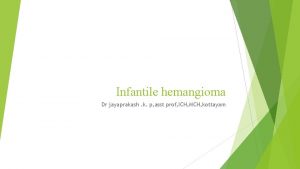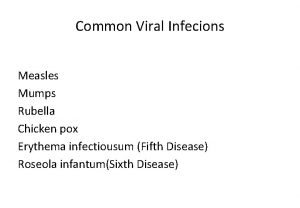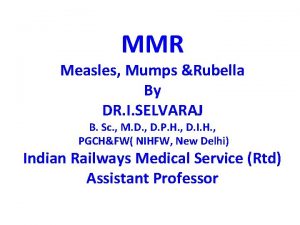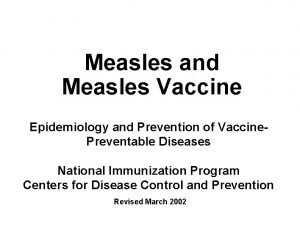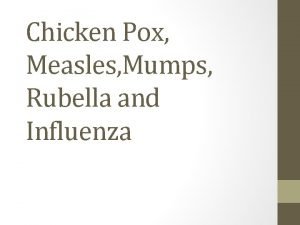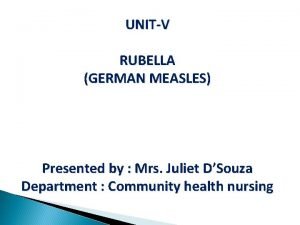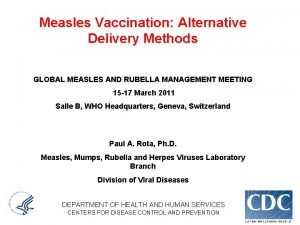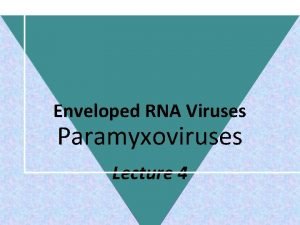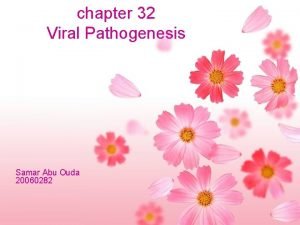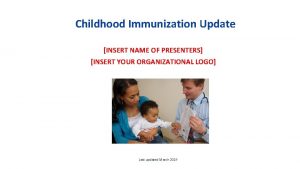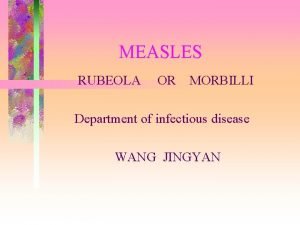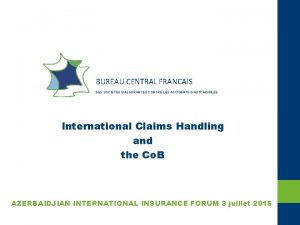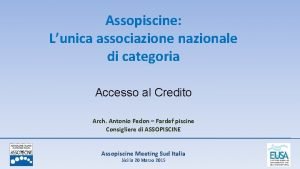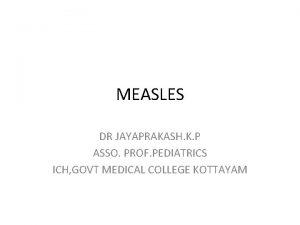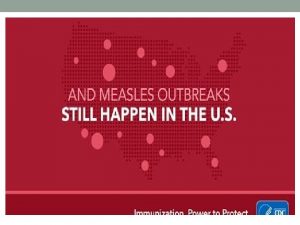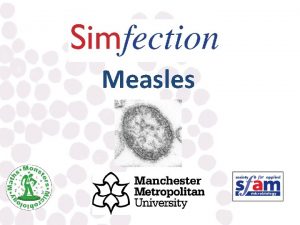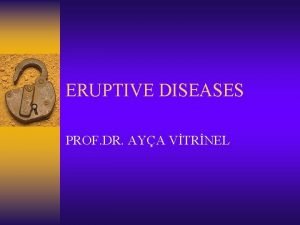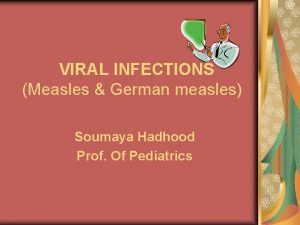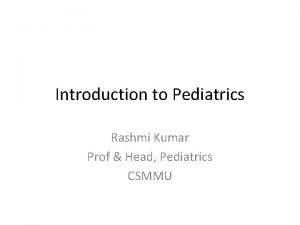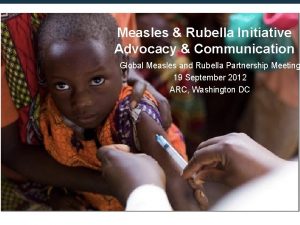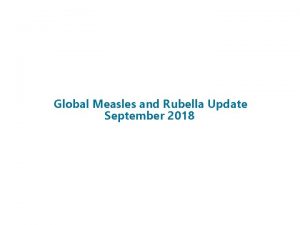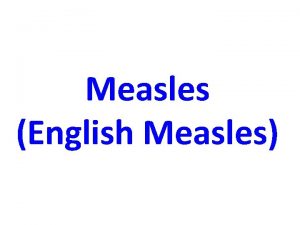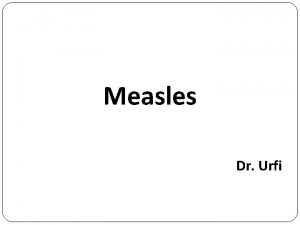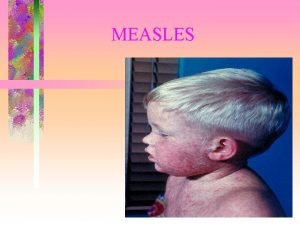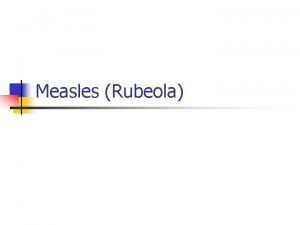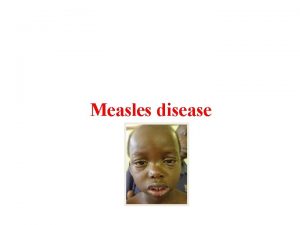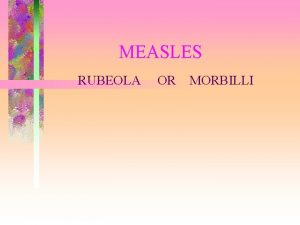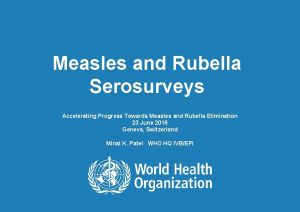MEASLES DR JAYAPRAKASH K P ASSO PROF PEDIATRICS




















- Slides: 20

MEASLES DR JAYAPRAKASH. K. P ASSO. PROF. PEDIATRICS ICH, GOVT MEDICAL COLLEGE KOTTAYAM

LEARNING OBJECTIVES • • To list essential features of clinical measles To list 2 complications of measles To write a treatment protocol for measles To suggest 2 interventions for prevention

AETIOLOGY • Measles virus is a single-stranded, lipidenveloped RNA virus in the family Paramyxoviridae and genus Morbillivirus

TRANSMISSION • The portal of entry of measles virus is through the respiratory tract or conjunctivae following contact with large droplets or small-droplet aerosols in which the virus is suspended. • Patients are infectious from 3 days before to up to 4 -6 days after the onset of rash.

PATHOLOGY • Measles infection causes necrosis of the respiratory tract epithelium and an accompanying lymphocytic infiltrate. • Measles produces small vessel vasculitis on the skin and on the oral mucous membranes.

PATHOGENESIS • Measles consists of 4 phases: • incubation period, prodromal illness, exanthematous phase, and recovery

CLINICAL MANIFESTATIONS • Measles is a serious infection characterized by high fever, an enanthem, cough, coryza, conjunctivitis, and a prominent exanthem. • After an incubation period of 8 -12 days, the prodromal phase begins with a mild fever followed by the onset of conjunctivitis with photophobia, coryza, a prominent cough, and increasing fever


• Koplik spots represent the enanthem and are the pathognomonic sign of measles, appearing 1 -4 days prior to the onset of the rash. • They first appear as discrete red lesions with bluish white spots in the center on the inner aspects of the cheeks at the level of the premolars

• The rash begins on the forehead (around the hairline), behind the ears, and on the upper neck as a red maculopapular eruption. • It then spreads downward to the torso and extremities, reaching the palms and soles in up to 50% of cases. • The exanthem frequently becomes confluent on the face and upper trunk

• With the onset of the rash, symptoms begin to subside. The rash fades over about 7 days in the same progression as it evolved, often leaving a fine desquamation of skin in its wake. • Of the major symptoms of measles, the cough lasts the longest, often up to 10 days

LAB INV • The diagnosis of measles is almost always based on clinical and epidemiologic finding

D/D • rubella, adenovirus infection, enterovirus infection, and Epstein-Barr virus infection. Exanthem subitum (in infants) and erythema infectiosum. • Group A streptococcus may also produce rashes similar to that of measles. • Kawasaki syndrome can cause many of the same findings as measles

COMPLICATIONS • Pneumonia is the most common cause of death in measles. The most common bacterialpathogens are Streptococcus pneumoniae, Haemophilus influenzae, and. Staphylococcus aureus. • Acute otitis media is the most common complication of measles

• Diarrhea and vomiting are common symptoms associated with acute measles • MALNUTRITION, VIT A DEFICIENCY • Febrile seizures, Measles encephalitis

• Subacute sclerosing panencephalitis (SSPE) is a chronic complication of measles with a delayed onset and an outcome that is nearly always fatal. • It appears to result from a persistent infection with an altered measles virus that is harbored intracellularly in the central nervous system for several years.

TREATMENT • Management of measles is supportive. • Vitamin A should be administered once daily for 2 days at doses of 200, 000 IU for children 12 mo of age or older; 100, 000 IU for infants 6 mo through 11 mo of age; and 50, 000 IU for infants younger than 6 mo of age. • In children with signs and symptoms of vitamin A deficiency, a 3 rd age-appropriate dose is recommended 2 through 4 wk after the 2 nd dose.

PREVENTION • Patients shed measles virus from 7 days after exposure to 4 -6 days after the onset of rash. Exposure of susceptible individuals to patients with measles should be avoided during this period. • MEASLES VACCINE AT 9 MONTHS &18 MONTHS

POST EXPOSURE PROPHYLAXIS • The vaccine is effective in prevention or modification of measles if given within 72 hr of exposure. • Immune globulin may be given up to 6 days after exposure to prevent or modify infection

OMP
 Prof dr jayaprakash
Prof dr jayaprakash Clostridium tetani
Clostridium tetani Measles artifact nuclear medicine
Measles artifact nuclear medicine Measles and mumps virus
Measles and mumps virus Measles ppt 2020
Measles ppt 2020 Multiple choice questions on chicken pox
Multiple choice questions on chicken pox Measles cases
Measles cases Kawasaki vs scarlet fever
Kawasaki vs scarlet fever Mrs measles
Mrs measles Measles cdc
Measles cdc Measles
Measles Pathophysiology of mumps
Pathophysiology of mumps Sspe measles
Sspe measles Measles cdc
Measles cdc Branny desquamation measles
Branny desquamation measles Compte asso
Compte asso Bureau central francais
Bureau central francais Lecompte asso
Lecompte asso Assopiscine
Assopiscine Le compte asso
Le compte asso Asso invoice
Asso invoice
